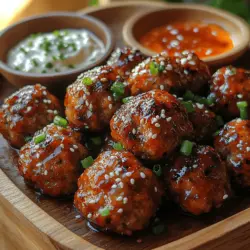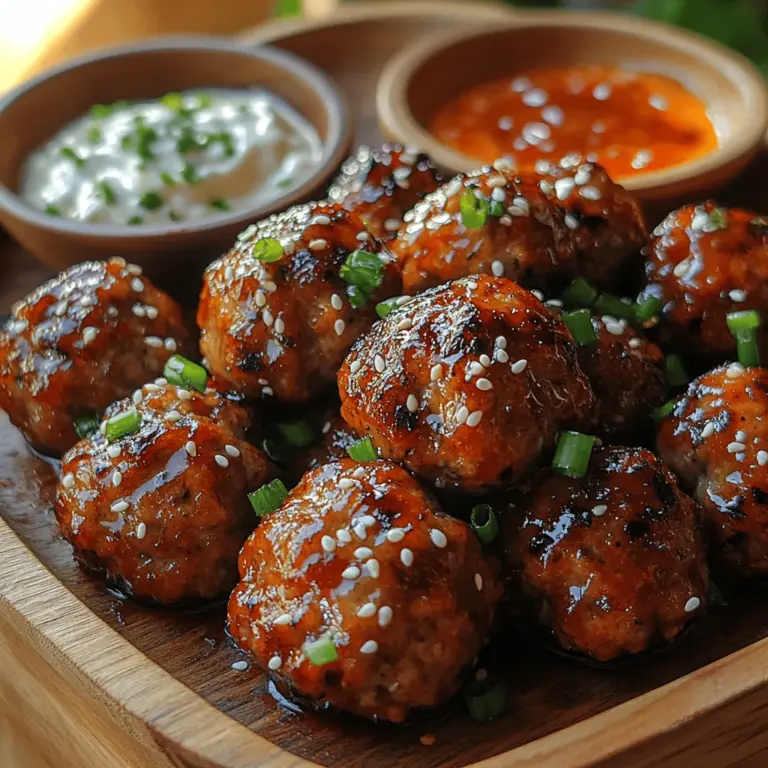Introduction to Korean BBQ Meatballs with Spicy Mayo Dip
Korean cuisine has taken the culinary world by storm, captivating food lovers with its harmonious blend of bold flavors and delicate textures. Among the many delectable dishes that showcase this cuisine’s unique characteristics, Korean BBQ Meatballs stand out as an irresistible option for both casual gatherings and sophisticated dinners alike. These savory meatballs are infused with spices and ingredients that create a symphony of taste, making them an ideal choice for those looking to explore the vibrant world of Korean flavors in a manageable and enjoyable form.
The growing popularity of Korean food can be attributed to its exciting flavor profiles and the influence of Korean pop culture. Dishes like bibimbap, kimchi, and bulgogi have gained immense popularity globally, leading many home cooks to experiment with Korean recipes in their kitchens. Korean BBQ Meatballs, in particular, offer a delightful fusion of sweet, spicy, and umami flavors, making them not only a crowd-pleaser but also an excellent introduction to the cuisine for those who may be less familiar.
Complementing the meatballs is a zesty Spicy Mayo Dip that elevates the dish to another level. This creamy, tangy sauce, typically made with mayonnaise and gochujang (Korean chili paste), adds a beautiful contrast to the savory meat with a hint of heat. The combination of the meatballs and the dip creates a dining experience that is both exciting and satisfying, allowing you to savor the essence of Korean BBQ right at home.
Understanding the Ingredients
To truly appreciate the deliciousness of Korean BBQ Meatballs, it’s essential to understand the key ingredients that contribute to their outstanding flavor. Each component plays a crucial role in achieving that authentic taste that makes this dish so special.
Ground Meat Choices
At the heart of these meatballs are the ground meat options, which typically include a blend of beef and pork. Ground beef offers a rich and robust flavor, while ground pork adds moisture and tenderness—together, they create a perfectly balanced meatball. The combination allows for a delightful bite that is both juicy and flavorful.
If you’re looking for alternatives, you can use ground turkey or chicken for a lighter version, but keep in mind that the texture and flavor profile will differ. The richness of beef and pork is hard to replicate, but experimenting with different meats can lead to unique and tasty variations.
Panko Breadcrumbs
Another standout ingredient is panko breadcrumbs. Unlike traditional breadcrumbs, panko is coarser and lighter, resulting in a meatball with a delightful texture that retains moisture while still achieving a crispy exterior when cooked. Panko helps the meatballs hold their shape and prevents them from becoming dense, allowing them to remain fluffy and tender.
If you don’t have panko on hand, you can substitute it with regular breadcrumbs, but the texture may not be as airy. For gluten-free options, look for gluten-free panko or breadcrumbs made from almond flour.
Aromatic Components
No Korean dish is complete without a robust flavor profile built on aromatic components. In this recipe, garlic, ginger, and green onions are essential for creating depth and complexity.
– Garlic provides a pungent and savory backbone, enhancing the overall taste of the meatballs.
– Ginger adds a warm, slightly spicy note that brightens the dish and balances the richness of the meat.
– Green onions (or scallions) lend a fresh, crisp element, contributing both flavor and color to the meatballs.
These aromatics not only enhance the flavor but also offer health benefits, such as anti-inflammatory properties and antioxidants.
The Flavor Enhancers
To elevate the taste of Korean BBQ Meatballs, several flavor enhancers are utilized, each bringing its unique character to the dish:
– Soy Sauce: A staple in many Asian cuisines, soy sauce adds a salty and savory depth that enriches the meat’s flavor.
– Gochujang: This Korean chili paste introduces a sweet and spicy kick, making it a vital player in achieving an authentic Korean taste. It’s known for its complex flavor profile, combining heat, sweetness, and umami.
– Sesame oil: A drizzle of sesame oil imparts a nutty aroma that rounds out the flavor, making the meatballs more aromatic and appealing.
– Honey: Used in moderation, honey balances the flavors with a touch of sweetness, complementing the heat from the gochujang and the saltiness from the soy sauce.
Together, these ingredients create a mouthwatering meatball that embodies the essence of Korean BBQ.
Health Considerations
When preparing Korean BBQ Meatballs, it’s important to consider the nutritional aspects, especially if you’re catering to specific dietary needs. While the combination of beef and pork provides a good source of protein, you can make adjustments for healthier options.
For those watching their calorie intake, using lean ground meats or substituting with ground turkey can reduce fat content. Additionally, incorporating vegetables such as grated carrots or finely chopped bell peppers into the meat mixture can enhance nutritional value while adding moisture.
For gluten-free diners, ensure the soy sauce is gluten-free and use gluten-free panko. These small adjustments can make this delicious dish accessible to a wider audience while still maintaining its core flavors.
Step-by-Step Guide to Making Korean BBQ Meatballs
Now that you have a deeper understanding of the ingredients and their significance, let’s delve into the preparation process for these delicious Korean BBQ Meatballs. The journey from raw ingredients to a flavorful dish is straightforward and rewarding, making it a fantastic choice for both novice cooks and seasoned chefs.
Mixing the Meatball Ingredients
The first step in creating these savory meatballs is to mix the ingredients. Start by gathering all your components in a large mixing bowl. Here’s a simple guide to ensure you achieve the perfect consistency and flavor balance:
1. Combine the Meats: Place the ground beef and pork in the bowl together. Using your hands or a spatula, gently mix the two meats until they are well incorporated. Avoid over-mixing, as this can lead to tough meatballs.
2. Add the Aromatics: Next, incorporate the minced garlic, grated ginger, and chopped green onions into the meat mixture. These ingredients should be evenly distributed throughout to ensure every bite is flavorful.
3. Incorporate the Bindings and Flavorings: Add the panko breadcrumbs, soy sauce, gochujang, sesame oil, and honey into the bowl. Use your hands to gently combine all the ingredients until just mixed. The mixture should be moist but not overly wet; it should hold together when shaped into balls.
4. Season to Taste: Before shaping the meatballs, taste the mixture (or cook a small portion in a skillet to check seasoning) and adjust the flavors as needed. You can add more soy sauce for saltiness, more gochujang for heat, or additional honey for sweetness, depending on your preference.
Shaping the Meatballs
Once your meatball mixture is ready, it’s time to shape them into perfectly round meatballs. Follow these simple techniques to ensure they hold their shape during cooking:
1. Prepare Your Work Surface: Lightly coat your hands with cooking spray or a small amount of oil to prevent the meat from sticking as you shape it.
2. Portion the Mixture: Use a tablespoon or an ice cream scoop to portion out the meat mixture. This ensures uniformity in size, which helps with even cooking.
3. Shape the Meatballs: Gently roll each portion of the mixture between your palms to form a ball. Aim for about 1 to 1.5 inches in diameter. Ensure that the meatballs are compact but not overly dense, as you want them to remain tender when cooked.
4. Arrange on a Baking Sheet: Once shaped, place the meatballs on a baking sheet lined with parchment paper or a silicone mat. Ensure they are spaced apart to allow for even cooking and to prevent them from sticking together.
5. Chill (Optional): For best results, consider chilling the meatballs in the refrigerator for about 30 minutes before cooking. This helps them firm up, making them easier to handle and reducing the risk of them falling apart during cooking.
With your meatballs prepped and ready, you are now poised to cook these delicious Korean BBQ Meatballs and prepare the accompanying spicy mayo dip. Stay tuned for the next steps, where we’ll explore cooking methods and finishing touches that bring this dish to life.
{{image_1}}
Baking the Meatballs
Once you’ve formed your meatballs, it’s time to bake them to perfection. Preheat your oven to 400°F (200°C). This temperature allows the meatballs to cook evenly while developing a beautiful golden-brown exterior, which adds to their flavor and visual appeal.
Tips for Achieving a Golden-Brown Exterior:
– Use Parchment Paper: Line your baking sheet with parchment paper to prevent sticking and ensure easy cleanup. The parchment also helps in achieving that desired crispiness on the bottom.
– Spacing: Ensure that the meatballs are spaced apart on the baking sheet. This allows hot air to circulate around them, promoting even cooking and browning.
– Avoid Overcrowding: Cooking in batches if necessary is essential. Overcrowding can lead to steaming rather than browning, resulting in softer meatballs.
Cooking Through Without Drying Out:
– Check Internal Temperature: Use an instant-read thermometer to check for doneness. The internal temperature should reach 165°F (74°C). If you don’t have a thermometer, cut one meatball in half to ensure it’s no longer pink in the center.
– Baste with Marinade: For an extra touch of flavor, consider basting the meatballs with a bit of the Korean BBQ marinade halfway through baking. This step adds moisture and enhances the umami flavor profile.
Bake the meatballs for approximately 20-25 minutes or until they are cooked through and golden brown. This method not only provides a healthier option compared to frying but also ensures that the meatballs maintain their juiciness and flavor.
Crafting the Perfect Spicy Mayo Dip
While the meatballs are baking, you can whip up a delicious spicy mayo dip that perfectly complements the savory flavors of the Korean BBQ meatballs.
Ingredients Breakdown
To prepare the spicy mayo dip, gather the following ingredients:
– Mayonnaise: The base of your dip, providing creaminess. Use full-fat mayonnaise for a richer flavor, or opt for a lighter version if you prefer.
– Sriracha Sauce: This adds a kick of heat. Adjust the amount based on your spice tolerance. Sriracha brings both flavor and heat, complementing the sweetness of the meatballs.
– Lime Juice: Freshly squeezed lime juice not only brightens the dip but also balances the richness of the mayonnaise with its acidity.
– Garlic Powder: A pinch of garlic powder enhances the umami flavor, giving the dip a savory depth.
– Sesame Oil (optional): A drizzle of sesame oil adds a nutty flavor that harmonizes beautifully with the Korean theme.
Whisking Techniques
To achieve a smooth and creamy consistency for your dip, follow these simple steps:
1. Combine Ingredients: In a small bowl, add the mayonnaise, sriracha, lime juice, garlic powder, and sesame oil (if using).
2. Whisk Vigorously: Use a whisk or fork to blend the ingredients thoroughly. Whisking not only mixes the components but also aerates the dip, making it light and fluffy.
3. Taste and Adjust: Once mixed, taste the dip. If you prefer it spicier, add more sriracha; for a creamier texture, incorporate more mayonnaise.
Adjusting Spice Levels
Everyone’s heat tolerance is different, so it’s important to adjust the spice levels to fit individual preferences:
– Mild: Start with 1 tablespoon of sriracha and gradually increase, tasting as you go.
– Medium: Use 2-3 tablespoons for a nice balance of flavor and heat.
– Fiery: For those who love heat, feel free to add more sriracha or even a pinch of cayenne pepper.
Once prepared, your spicy mayo dip should be creamy, tangy, and packed with flavor, making it the perfect accompaniment for the Korean BBQ meatballs.
Serving Suggestions and Presentation Ideas
Now that your meatballs and spicy mayo dip are ready, it’s time to serve them in an appealing way that enhances the dining experience.
Plating Techniques
Presentation matters, especially when sharing food with friends and family. Here are some creative plating techniques to consider:
– Use a Serving Platter: Arrange the meatballs in a circular pattern on a large serving platter. This not only looks inviting but also makes it easy for guests to help themselves.
– Garnish: Sprinkle sesame seeds and finely chopped green onions over the meatballs to add color and texture. The contrast against the dark meatballs creates an appetizing visual.
– Dip Bowl: Place the spicy mayo dip in a small bowl in the center of the platter. This keeps the dip easily accessible while adding a decorative element.
Pairing Suggestions
To elevate your meal, consider serving the Korean BBQ meatballs with complementary side dishes and beverages:
– Rice: Steamed jasmine or sticky rice makes a great side, absorbing the flavors of the meatballs.
– Vegetables: Pair with a simple cucumber salad or pickled vegetables to add a refreshing crunch that balances the richness of the meatballs.
– Beverages: Serve with a light beer or a fruity Asian-inspired cocktail, such as a lychee martini, to enhance the experience.
Serving Occasions
Korean BBQ meatballs with spicy mayo dip are perfect for various occasions:
– Family Dinners: This dish can be a hearty main course for a casual family meal, offering a taste of Korean cuisine that everyone can enjoy.
– Parties and Gatherings: The meatballs are easy to serve and share, making them the ideal appetizer or main dish for parties, game nights, or potlucks.
– Casual Get-Togethers: Cook these meatballs for a relaxed gathering with friends. They are sure to impress with their flavor and presentation.
Conclusion
Creating Korean BBQ meatballs with spicy mayo dip is not just about cooking; it’s about bringing people together through delicious food. This recipe allows you to explore the rich flavors of Korean cuisine while enjoying the satisfaction of making a meal from scratch.
The ease of preparing this dish at home ensures that you can share it with loved ones without stress. Whether you’re hosting a dinner party or enjoying a casual night in, these meatballs are sure to be a hit.
As you explore the versatility of Korean cuisine, consider trying different variations of this recipe. Substitute proteins, experiment with different dipping sauces, or incorporate seasonal vegetables. The culinary world is vast, and each dish offers an opportunity for creativity and connection. Enjoy the journey in your kitchen, and happy cooking!



